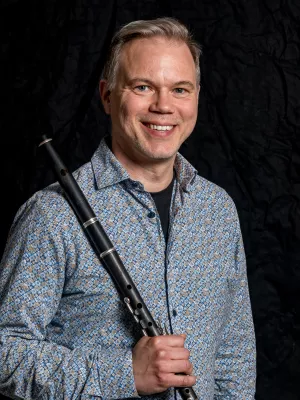
Markus Tullberg
Lärare

Wind and Wood : Affordances of Musical Instruments: The Example of the Simple-System Flute
Författare
Summary, in Swedish
Empirical data is generated through two qualitative studies. Study A consists of interviews with six flute players, including one flute maker. Together they represent a variety of European music traditions, and hence, the simple-system flute is perceived and used in different ways. In the cooperative inquiry of Study B, six flute players came together to investigate their own musical practice and approach towards their instruments.
The central analytical concept is affordances, as coined by ecological psychologist James J. Gibson. The concept of affordances is combined with ideas from the emerging research paradigm of 4E cognition, in particular ideas from the extended and enactive dimensions.
Through the analysis, affordances of musical instruments are defined as: perceived opportunities for actions arising from the sensorimotor relationship of the interaction with the instrument, as these unfold in the flow of musical practice.
The analysis also shows that the cross-modal perceptual experience of the instrument varies between musicians. Viewed through the lens of affordances, this variation entails qualitatively different ways of playing.
The perspective on musical learning that emerges through the analysis is discussed in terms of self-organization in which the development of the relationship between musician and instrument allows for an increasing capacity to perceive and act upon affordances of the instrument.
This perspective on musical learning implies an understanding of music education as a form of eduction, where the learner is given appropriate space for self-organization and the educator assumes to role of sense-maker of the learning process, and facilitator and moderator of new musical experiences. The dynamic relationship between the individual learner and the educational environment is articulated as an ecological responsibility.
Avdelning/ar
- Lärare (Musikhögskolan)
- CogComlab
- Humanistlaboratoriet
Publiceringsår
2021-02-19
Språk
Engelska
Publikation/Tidskrift/Serie
Studies in Music and Music Education
Issue
23
Fulltext
- Available as PDF - 13 MB
- Download statistics
Dokumenttyp
Doktorsavhandling
Förlag
Musikhögskolan i Malmö, Lunds universitet
Ämne
- Music
- Pedagogy
Nyckelord
- Music education
- Musical affordances
- Musical instruments
- Ecological Psychology
- 4e cognition
- Cooperative inquiry
- Musikundervisning
- Musikinstrument
- Affordances
- Ekologisk psykologi
- 4e cognition
Status
Published
Forskningsgrupp
- CogComlab
Handledare
- Eva Saether
- Göran Folkestad
ISBN/ISSN/Övrigt
- ISSN: 1404-6539
- ISBN: 978-91-88409-26-3
Försvarsdatum
19 mars 2021
Försvarstid
10:00
Försvarsplats
NB! This dissertation defense will be conducted online only. https://lu-se.zoom.us/s/64173877614
Opponent
- Dan Lundberg (docent)